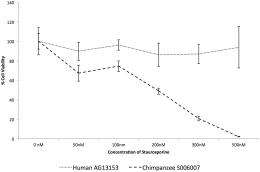Viability of human and chimpanzee primary fibroblasts after treatment with staurosporine. Credit: (c) PLoS ONE 7(9): e46182. doi:10.1371/journal.pone.0046182
(Phys.org)—Researchers from the Georgia Institute of Technology have published a paper in the journal PLOS ONE highlighting their study comparing the rate of cell apoptosis between humans, chimps and macaque. Their finding that human rates were the slowest of the group led them to suggest that such a slow rate may account for a larger brain size in humans and possibly increased rates of cancer.
Cell apoptosis is a process whereby cells self destruct when they become old, damaged or are no longer needed. It's a process that allows for body parts to grow into their correct shape and also helps to prevent the growth of tumors. In this new research, the team studied the rates at which cell apoptosis occurs in different primates, theorizing that a slower rate would allow for less apoptosis pruning of old neural pathways allowing for larger brain growth. This idea has previously been backed up by other studies that have shown that mice with protein executioner caspases disabled – which regulate the rate of apoptosis – develop larger than normal brains.
To learn more about the different rates of apoptosis in primates, the team applied apoptosis stimulating chemicals to the skin of test subjects and found that compared to chimps and macaque, human cells appear reluctant to self destruct. Fewer skin cells died and there was less deformation, a sign that a cell is preparing to signal its demise.
But a slower rate of apoptosis has also been shown to increase the risk of developing cancerous tumors, which led the team to theorize that the same mechanism that led to humans having larger brains, also led to increased rates of cancer. One hitch in that assumption, however, as Todd Preuss of the Yerkes National Primate Research Center, points out in a conversation with New Scientist, is that there isn't enough cancer rate data available in other primates to say for certain whether human rates are higher or not. He adds that slower rates of apoptosis in humans may account for longer life spans, which he says is also likely partly responsible for larger brains as it allows more time for learning and teaching offspring.
More information: Arora G, Mezencev R, McDonald JF (2012) Human Cells Display Reduced Apoptotic Function Relative to Chimpanzee Cells. PLoS ONE 7(9): e46182. doi:10.1371/journal.pone.0046182
Abstract
Previously published gene expression analyses suggested that apoptotic function may be reduced in humans relative to chimpanzees and led to the hypothesis that this difference may contribute to the relatively larger size of the human brain and the increased propensity of humans to develop cancer. In this study, we sought to further test the hypothesis that humans maintain a reduced apoptotic function relative to chimpanzees by conducting a series of apoptotic function assays on human, chimpanzee and macaque primary fibroblastic cells. Human cells consistently displayed significantly reduced apoptotic function relative to the chimpanzee and macaque cells. These results are consistent with earlier findings indicating that apoptotic function is reduced in humans relative to chimpanzees.
Journal information: PLoS ONE
© 2012 Phys.org




















